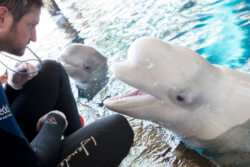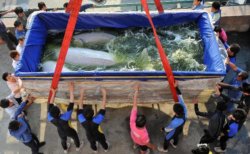The Shedd Aquarium in Chicago has announced that Mauyak, one of the belugas there, is pregnant with a calf due next summer. They wrote: “We are looking forward to bringing our guests with us every step of the way and sharing the wonder of beluga whale development.”
I, too, hope that Mauyak gives birth successfully. But while free-ranging beluga whales can live for 50 to 60 years, captive belugas routinely die before the age of 30.

Mauyak (right) and Kimalu at the Shedd Aquarium. By Chicago Tribune
Mauyak was captured in 1982 in Canada’s Hudson Bay when she was just two years old. And while marine display parks like to refer to their captive whales as “our family,” Mauyak has not seen her own family since she was taken. Instead, since she has been shuffled around from one aquarium to another: first to Point Defiance Zoo, then to Shedd Aquarium, then to Mystic Aquarium, and finally back to Shedd in 2009.
Of the four calves to whom she has given birth, just one, her six-year-old daughter Kimalu, survives. Of the three others, one was stillborn, one died the same day he was born, and another died at Mystic Aquarium in Connecticut at the age of nine. This history is typical for belugas who are born in concrete tanks. The Shedd Aquarium has had nine beluga deaths in the past 29 years; about one death every three years. This is the depressing reality behind the captive beluga industry anywhere you go.

The Georgia Aquarium in Atlanta
At the Georgia Aquarium, six belugas have died since the facility opened just 13 years ago. None of them lived beyond age 26. One of them, a female named Maris, lost two calves in the span of three years and then died in 2015 at age 21, five months after the death of her second calf. The cause of her death has never been explained.
In Canada the situation is no better. At the Vancouver Aquarium, five young belugas have died in the past eight years, including a mother and daughter, Aurora and Qila, who died nine days apart and for whom cause of death has never been determined. Their lives were marked by suffering. Aurora lost three calves before she was 29 and her daughter Qila also lost one.
Most notorious among North American marine display parks, Marineland Canada currently holds about 58 belugas (it’s hard to be precise since births and deaths are so frequent) with at least 36 beluga deaths to their name since the early 1990s.

Belugas being unloaded from Russia at China’s Huangzhou Polar Ocean Park. (Xinhua/Wang Dingchang
The record abroad, particularly in China, is not well documented but probably much worse.
So, while we all hope that Mauyak’s calf is born healthy and lives beyond infancy, we must face the sober truth that belugas and concrete tanks do not mix. Moreover, captive belugas often exhibit abnormal behavior, like stereotypies (repetitive behaviors with no clear purpose) and other signs of chronic stress.
Yet the captive entertainment industry continues to confine these whales to tanks and force them to breed under unnatural circumstances leading to death, suffering and loss. No wonder the Shedd Aquarium, Georgia Aquarium and SeaWorld were part of an attempt in 2013 to gain a permit from NOAA to import 18 beluga whales caught in Russia’s Sea of Okhotsk.
Belugas are no more suited to living in aquariums than orcas are.This was the first application for a permit to import recently caught wild marine mammals in more than 20 years – an effort that went against the decision the marine mammal captivity industry in the U.S. had made in the wake of public anger when news footage was shown of similar captures in U.S. waters.
This application was denied, in part because NOAA determined that many of the 18 belugas were only about a year old and still nursing at the time these facilities wanted to set them on the long journey from a crowded holding pen in Russia to be distributed among the U.S. aquariums. (The aquariums may still attempt to overturn the NOAA permit denial in the future and we should be ever-vigilant and prepared for this possibility.)
Captive belugas are sending a clear and powerful message to their captors with their poor welfare, short lives and high numbers of deaths. They cannot thrive, let alone survive for very long, in concrete tanks. So, while the public may understandably, be more focused on orcas and their plight in and out of captivity, we should be ever mindful of the continued suffering of captive belugas, who are no more suited to living in aquariums than orcas are.
Let’s remember the words (yes, words) of a beluga named NOC, who was kidnapped from his family in 1977. NOC mimicked human speech during his 22 years of confinement in a concrete tank by the National Marine Mammal Foundation. Among his first words heard by a diver cleaning his tank were the most telling of all: “Out, out, out!”
We hope that Mauyak’s baby will have a different fate than NOC’s and live her life in a seaside sanctuary where she will know better what it is like to be a beluga.
6 Comments
Have been watching episodes of The Aquarium, which is in Atlanta, GA. Tonight’s episode was re Whisper a Beluga whale, who gave birth. Altho beautiful, it is disturbing. Now there will be 6! in the tank. Whales do not belong in tiny tanks! Neither do dolphins! Pray the Russians do not trap any further belugas!
These animals have no business being in tanks. There is no educational value to watching an animal in an UNnatural environment! They are going to act differently, because they’re completely removed from their natural surroundings. Nothing educational about slavery.
How dare human beings treat fellow animals like this I am totally ashamed of the human race , to think we are superrior to these gentle intelligent creatures that should be in the sea free… free the Whales ! Free the Whales !!!
No more captivity!
There should never be anymore captive marine mammals that require the entire ocean to survive. They should no longer be allowed to breed and be set aside as candidates for the sanctuary.
What is the status on sanctuaries, has there been a location selected?
Poor Mauyak. I am constantly stunned by the complete lack of compassion and empathy for these animals.
Would you want to live in an emtypy concrete tank all your days? One that is completely devoid of *everything* in your natural environment?
Why the hell do you think they did testing on humans in the desert pretending what it would be like to live on Mars? But I digress.
The point is, this is wrong. They are sentient. They need their natural environment same as we need ours.
Captivity kills.